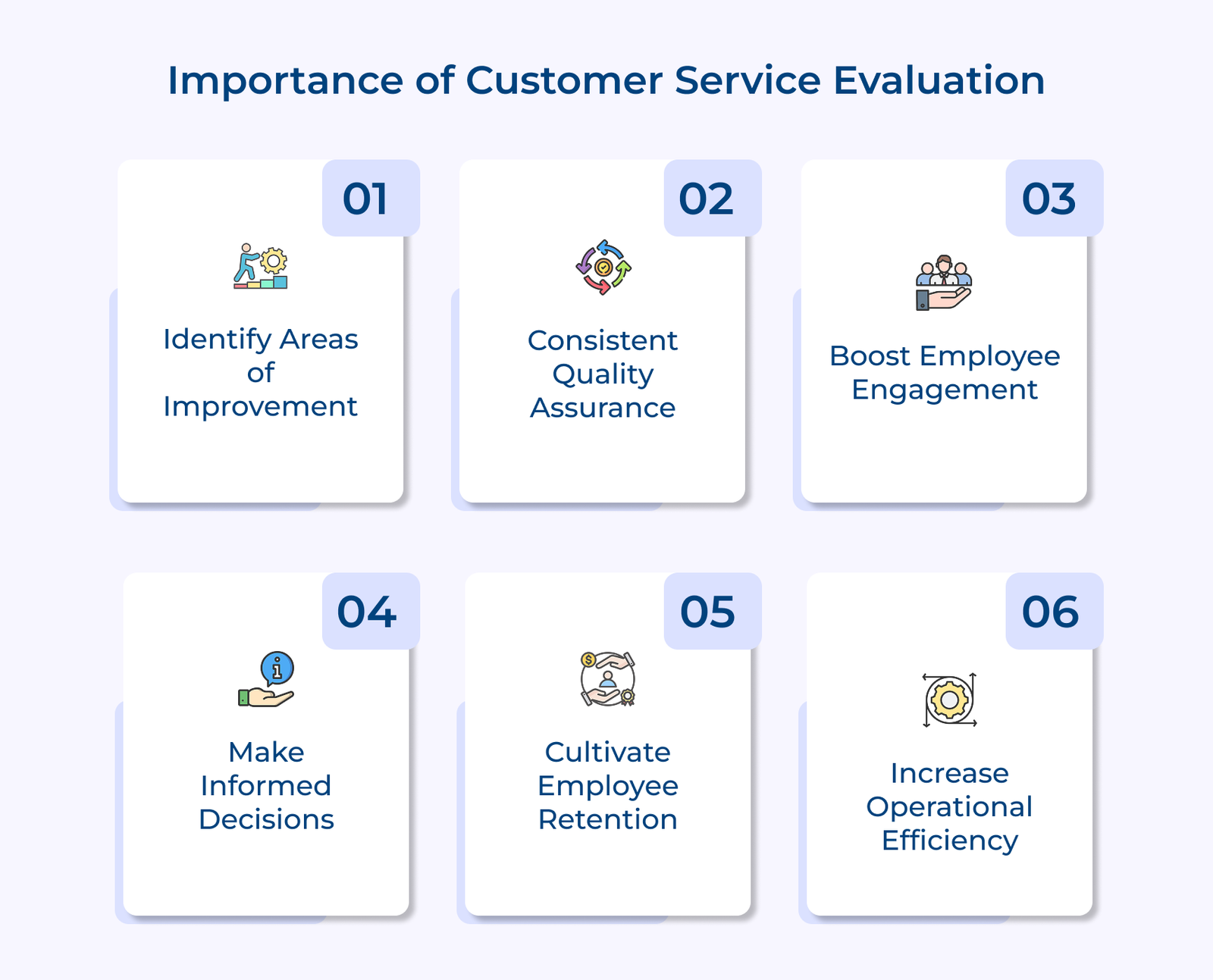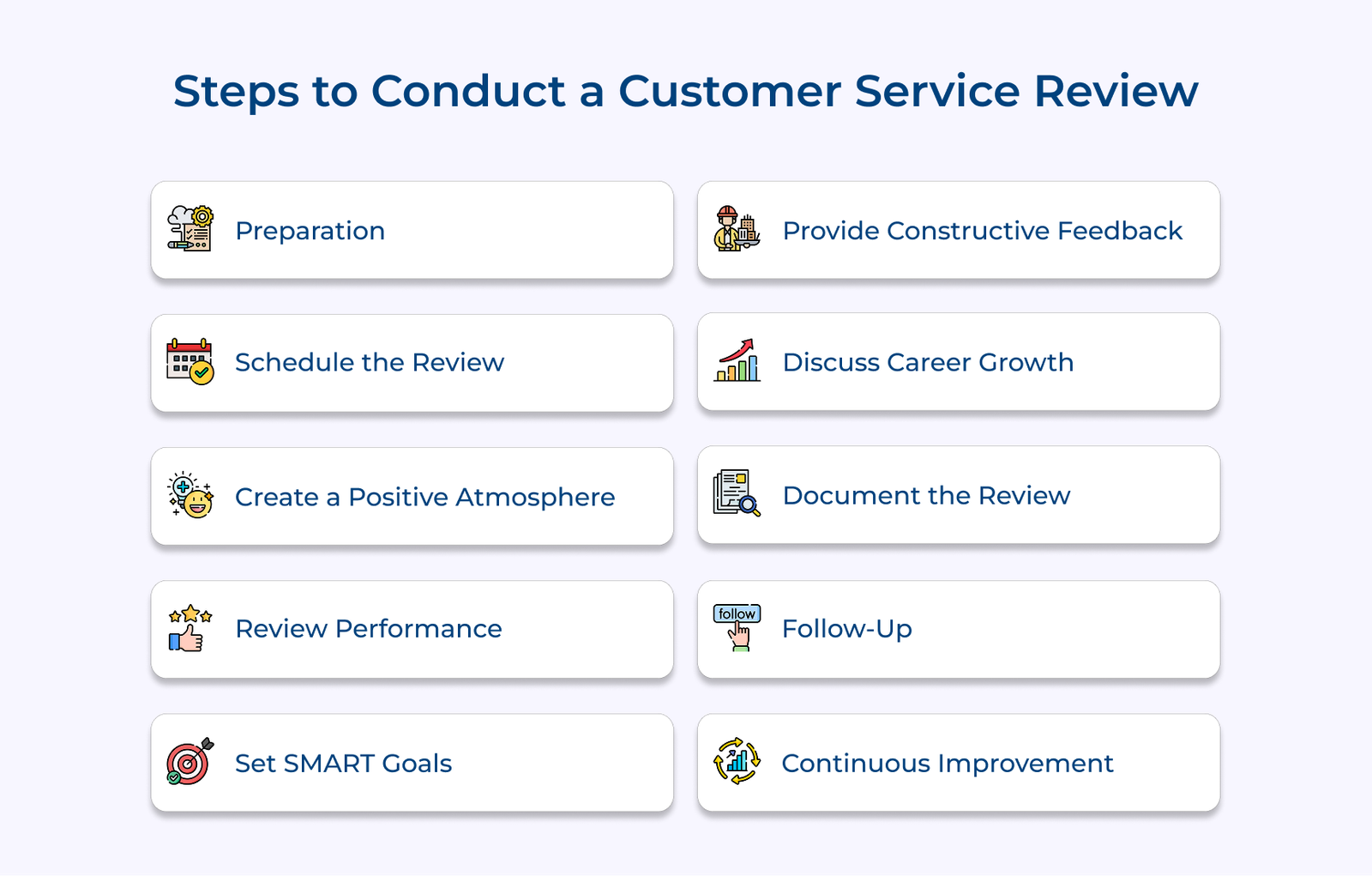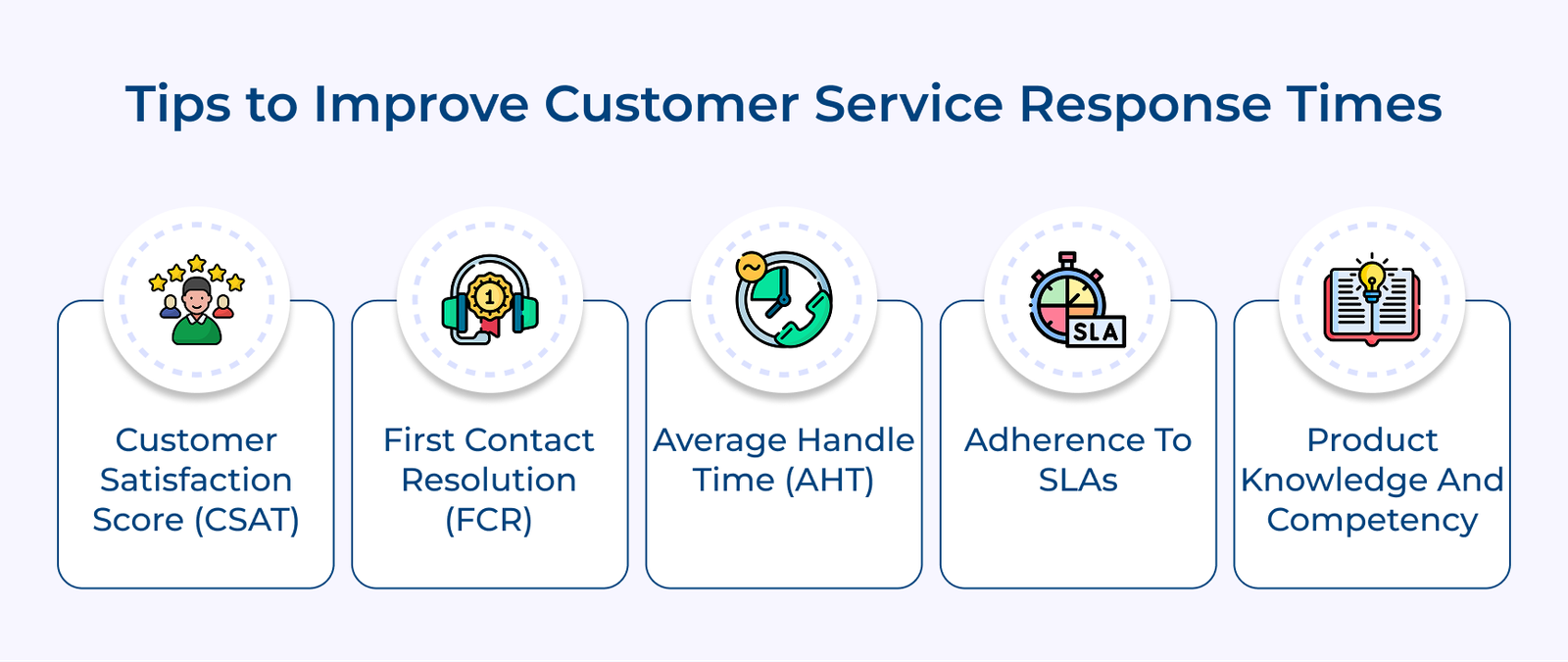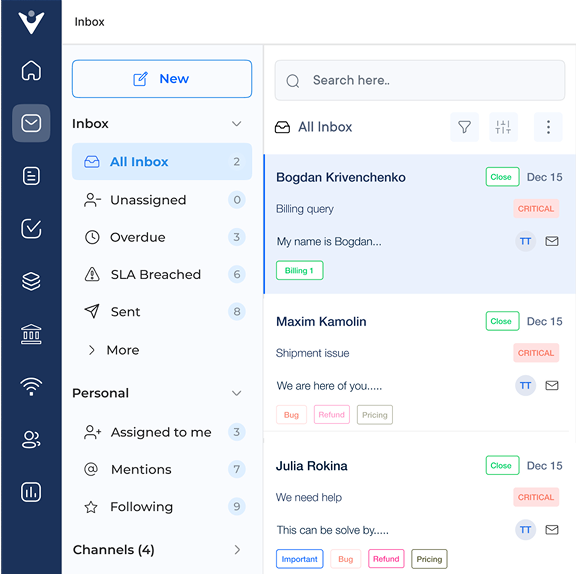1. Preparation
Conducting an effective customer service performance review begins with thorough preparation. First, gather relevant data and documentation that provide insights into the employee’s performance. It includes customer feedback, survey results, performance metrics, statistics, call recordings, or interaction logs. The sources offer valuable information about the employee’s strengths, areas for improvement and customer service delivery.
Review the employee’s job description to ensure a clear understanding of the expectations and responsibilities associated with their role. Identify areas where the employee excels and consistently meets the standards, as well as areas where there is room for improvement.
Pro tips:
- Involve the employee in the data collection process. Ask them to self-evaluate their performance and provide examples of their accomplishments
- Ensure that the data and documentation cover a reasonable timeframe, providing a comprehensive view of the employee’s performance
- Maintain objectivity and avoid personal biases by focusing on factual information
2. Schedule the Review
Scheduling a customer service performance review is a crucial step in ensuring efficient and effective service delivery. Choose a time and location that allows for undivided attention along with minimal disruptions. A quiet, private meeting room or office is ideal.
Provide ample notice to the employee, preferably at least a week in advance, to allow them to prepare and gather any necessary documentation or examples. Minimize distractions by closing doors, silencing phones and avoiding interruptions during the review session.
Best practices:
- Mutual timing: Collaborate with the employee to find a mutually convenient time, demonstrating respect for their schedule and increasing their engagement
- Neutral location: Consider conducting the review in a neutral location, such as a conference room or off-site, to eliminate potential distractions
- Set agenda: Provide an agenda or outline to the employee beforehand. It allows them to understand the structure and focus areas of the review, facilitating a productive discussion.
3. Create a Positive Atmosphere
Creating a positive atmosphere for conducting a customer service performance review is essential for enhancing open communication and constructive feedback. Begin by setting a collaborative tone, emphasizing the review as a joint effort to identify strengths, areas for improvement and opportunities for professional growth.
Encourage open communication by asking thought-provoking questions and actively listening to the employee’s perspectives. The two-way dialogue promotes engagement and a shared understanding. Establish a non-judgmental environment by maintaining a professional demeanor, acknowledging both achievements and areas for development without criticism.
Key benefits:
- A positive atmosphere enhances trust, enabling the employee to feel comfortable sharing their experiences, concerns and suggestions
- It enhances a growth mindset, where constructive feedback is embraced as an opportunity for personal and professional development
- A supportive approach increases employee motivation, engagement and commitment to delivering exceptional customer service
4. Review Performance
Evaluating performance is an essential step in conducting a thorough and effective customer service review. Begin by discussing specific examples that illustrate the employee’s strengths, areas for improvement and performance. Provide concrete evidence and data to support the assessments.
Highlight achievements and successes, acknowledging instances where the employee excelled in delivering exceptional customer service. Celebrate their contributions and the positive impact they have had on customer satisfaction.
Use cases:
- Discussing specific instances allows for targeted feedback and actionable steps for enhancing performance in identified areas of improvement
- Highlighting successes boosts employee morale, recognition and motivation, encouraging continued excellence.
- Reviewing performance with concrete examples provides a solid foundation for setting measurable goals and tracking progress in future reviews.
5. Set SMART Goals
Setting SMART (Specific, Measurable, Achievable, Relevant and Time-bound) goals is a critical step in conducting an effective customer service performance review. Setting challenging but achievable goals leads to 90% better performance. Clearly define goals that are specific to the employee’s role, ensuring they are measurable through quantifiable metrics. Goals should be achievable yet challenging, stretching the employee’s capabilities while remaining realistic.
Align the goals with the organization’s broader objectives, ensuring they contribute to service excellence and customer satisfaction. Encourage employee input and buy-in by involving them in the goal-setting process, enhancing ownership.
Importance of it:
- SMART goals provide a clear roadmap for performance improvement, guiding the employee’s focus and efforts
- Measurable goals enable accurate tracking and assessment of progress, facilitating data-driven decision-making
- Employee involvement in goal-setting enhances motivation, accountability and a shared understanding of expectations, driving better customer service outcomes
6. Provide Constructive Feedback
Providing constructive feedback is crucial to an effective customer service performance review. Focus on behaviors and actions, rather than personal traits or characteristics, to maintain objectivity. Offer specific and actionable suggestions for improvement, detailing the steps the employee can take to enhance their performance.
Encourage self-reflection and accountability by inviting employees to share their perspectives, enhancing a collaborative dialogue. The approach empowers the individual to take ownership of their development and growth.
Things to consider:
- Craft feedback using a respectful and supportive tone, avoiding harsh criticism or personal attacks. It can undermine motivation and damage the working relationship.
- Balance constructive criticism with recognition of achievements, reinforcing positive behaviors and boosting confidence.
7. Discuss Career Growth
A key aspect of the customer service performance review process is identifying areas for development and exploring training opportunities to upskill employees. Employees can enhance their capabilities, stay current with industry trends and provide even better service.
Leaders must have an open dialogue about personal career goals and how those can be aligned with the organization’s objectives. Developing customer service skills is mutually beneficial – it helps employees grow professionally while enabling the company to deliver a superior customer experience.
Best practices:
- Getting input from the employees on areas they want to develop and the training they feel would be valuable.
- Analyzing performance data, customer feedback and quality scores to pinpoint specific skill gaps that could be addressed through training.
- Exploring cross-training opportunities in other customer service roles or departments to expand the employee’s knowledge and capabilities.
8. Document the Review
Properly documenting the performance review is crucial for ensuring accountability and providing a clear record of the discussion. Key points, areas of strength, opportunities for improvement and any agreed-upon actions or development plans should be recorded in detail. Both the manager and employee should sign off on the documentation to acknowledge their participation.
Maintaining confidentiality is also essential when handling performance review documents. They should be stored securely, with access restricted to authorized personnel only. Proper document storage procedures help protect employee privacy while also ensuring reviews can be easily referenced for future planning.
Best practices:
- Using a standardized template or form to ensure consistency across all employees.
- Allowing time after the review discussion for both parties to review the documentation before providing final signatures. It ensures an accurate record.
- Providing copies of the signed document to the employee while also maintaining the original in a secure HR file.
9. Follow-Up
Effective follow-up is essential for ensuring the performance review leads to meaningful growth and development. Regular check-ins should be scheduled to discuss progress on any agreed-upon goals, training plans, or areas for improvement identified during the review. Managers can provide ongoing support, coaching and resources to facilitate the employee’s success.
Let’s assume that an employee aimed to improve their expertise in the company’s product lineup, knowledge assessments, and the impact on customer interactions. Successes like higher satisfaction scores or positive customer feedback could then be highlighted and rewarded.
- Establishing a cadence for check-ins, whether weekly, monthly or quarterly.
- Documenting updates and adjusting development plans as needed based on progress.
- Continuously soliciting employee feedback to understand any barriers or additional support needed.
Customer Service Performance Review Phrases
Discover a comprehensive collection of effective phrases to use in your customer service performance reviews.


















